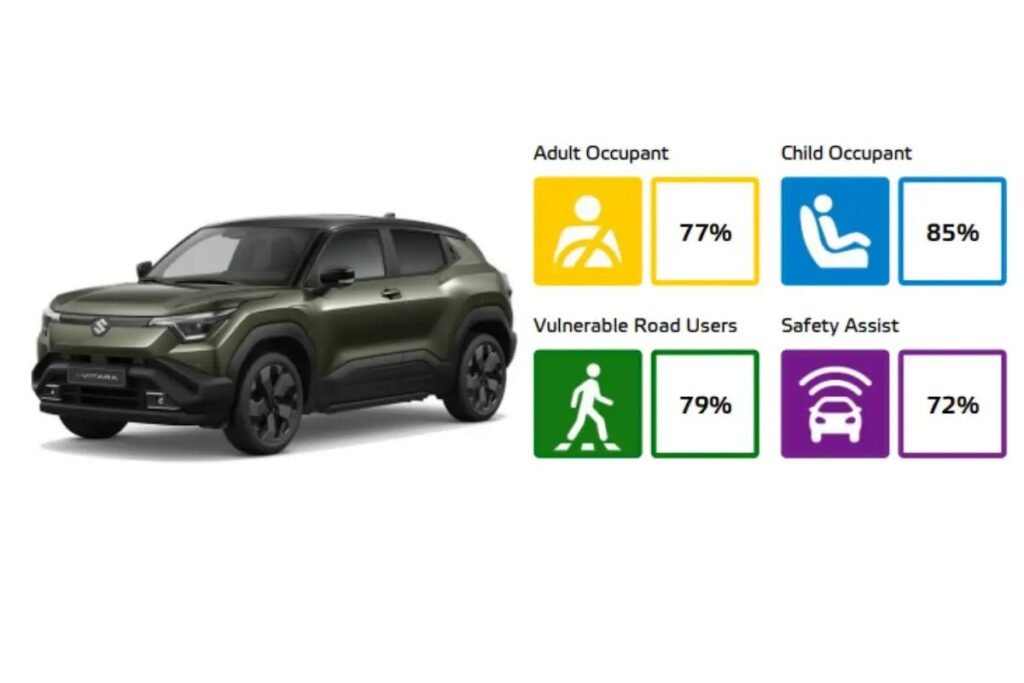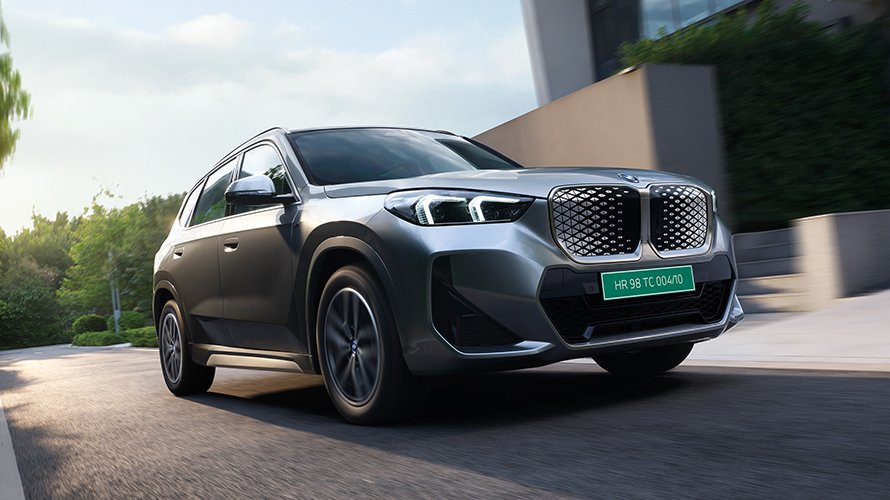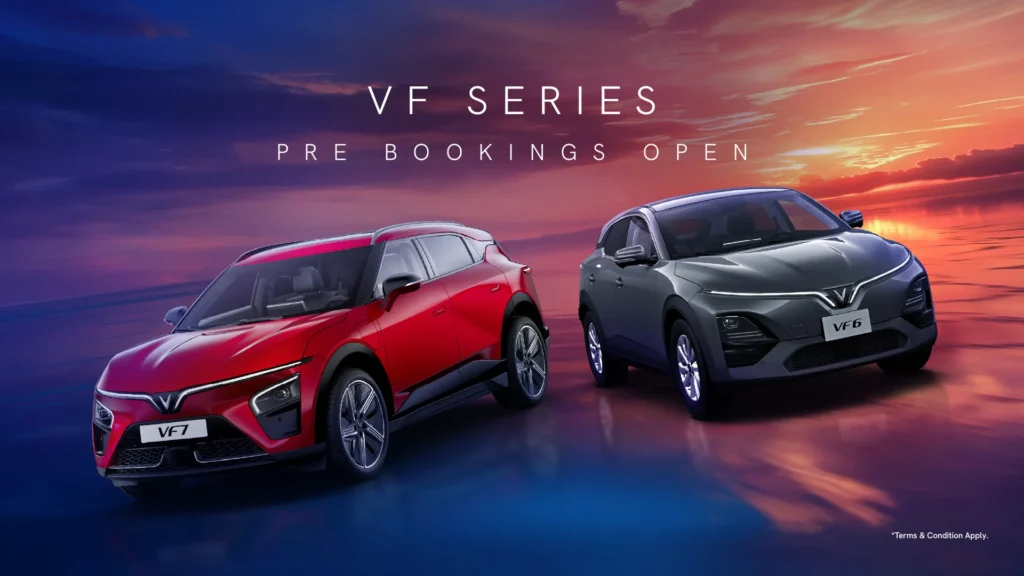Maruti Suzuki, India’s largest carmaker, has achieved a significant milestone with its first electric SUV, the e-Vitara, earning a 4-star overall safety rating from the stringent Euro NCAP crash tests.This achievement underscores the vehicle’s robust build quality and advanced safety features, particularly impressive as it’s manufactured in India at Maruti’s Gujarat facility. While the e-Vitara’s launch in the domestic market remains tentative—potentially slated for late 2025 or early 2026—the company has already begun exporting units to Europe, signaling confidence in its global competitiveness.Countries like the United Kingdom, Germany, Norway, France, Denmark, Switzerland, and the Netherlands are among the first to receive shipments, with Toyota’s rebadged version, the Urban Cruiser Electric, following suit.
The Euro NCAP results, announced on September 9, 2025, highlight the e-Vitara’s performance across key categories, though it falls short of the 5-star benchmark achieved by some rivals. Built on Suzuki’s dedicated EV platform, the tested variant was the 61kWh GLX left-hand-drive (LHD) model, with results applicable to all variants, including those for Toyota.This marks the first time a made-in-India Maruti Suzuki vehicle has undergone Euro NCAP evaluation, a tougher protocol than Global NCAP or Bharat NCAP, emphasizing real-world protection and advanced driver assistance systems (ADAS).
Detailed Breakdown of Euro NCAP Performance
Euro NCAP assesses vehicles on four pillars: Adult Occupant Protection (AOP), Child Occupant Protection (COP), Vulnerable Road User (VRU) Protection, and Safety Assist. The e-Vitara’s scores reflect a balanced but not flawless safety profile.
1.Adult Occupant Protection (77%): The e-Vitara earned 31 out of 40 points here, providing good protection for the knee and femur areas of front occupants in frontal offset tests. The passenger compartment remained stable during impacts, and dummy readings indicated adequate chest protection. Notably, it offers good whiplash protection in rear-end collisions, thanks to well-designed front seats and head restraints. However, rear passenger chest protection was rated as marginal in full-width frontal impacts, pulling down the score slightly.
2.Child Occupant Protection (85%): This was the e-Vitara’s strongest category, scoring 41 out of 49 points. It provided good overall protection to critical body areas for child dummies in both frontal offset and side barrier tests.The vehicle’s structure effectively restrained child seats, and it features ISOFIX mounts as standard. Euro NCAP praised the dynamic performance in child safety scenarios, making it a reliable choice for families.
3.Vulnerable Road User Protection (79%): Scoring 37.5 out of 48 points, the e-Vitara performed well in pedestrian and cyclist impact tests, with good to adequate head protection across the bonnet. Its autonomous emergency braking (AEB) system effectively detects and mitigates risks to VRUs. However, protection was poor near the windscreen pillars and the base/top of the windscreen, areas where pedestrians could suffer severe injuries.
Safety Assist (71%): The e-Vitara includes a comprehensive suite of ADAS features, such as AEB for car-to-car, vulnerable road users, and motorcyclists; lane keep assist; speed assistance; and driver fatigue detection. It also comes with seven airbags, electronic stability control (ESC), and a 360-degree camera as standard. While these systems scored well in functionality, the overall rating was tempered by limitations in cyclist detection and rear pedestrian alerts.
| Category | Score (%) | Key Strengths | Areas for Improvement |
|---|---|---|---|
| Adult Occupant Protection | 77 | Good knee/femur & whiplash protection | Marginal rear chest protection |
| Child Occupant Protection | 85 | Excellent in frontal & side tests | None noted |
| Vulnerable Road Users | 79 | Effective AEB for pedestrians/cyclists | Poor protection at windscreen edges |
| Safety Assist | 71 | Comprehensive ADAS suite | Limited cyclist/rear detection |
Overall, the 4-star rating positions the e-Vitara as a solid performer in the compact electric SUV segment, where safety is paramount for EV adoption.
The e-VitarThe e-Vitara: Maruti’s EV Ambition Takes Shape
The e-Vitara is Maruti Suzuki’s entry into the electric SUV market, measuring around 4.3 meters in length with a rugged, boxy design reminiscent of the Grand Vitara but tailored for electrification. It offers two battery options: a 49kWh pack for entry-level trims (around 400km range) and a 61kWh unit for longer-range variants (up to 550km WLTP).Power comes from single- or dual-motor setups, delivering up to 175kW (235hp) and all-wheel drive in top specs. Features include a 10.25-inch touchscreen with wireless Apple CarPlay/Android Auto, ventilated seats, a panoramic sunroof, and Level-2 ADAS—making it the first Maruti with such advanced tech.
Priced at approximately €35,000-€45,000 (₹32-41 lakh) in Europe, it’s aimed at urban buyers seeking affordability and efficiency.In India, expectations are for a sub-₹25 lakh starting price to compete with the Tata Curvv EV and Mahindra XUV400, bolstered by FAME-III subsidies and local production.Exports began in August 2025, with over 2,900 units shipped initially, highlighting Maruti’s shift toward global EV leadership.This aligns with Suzuki’s broader strategy, including a new EV plant in Gujarat with a 2.5 lakh annual capacity by 2027.
Implications for India and Global Markets
For Indian consumers, the e-Vitara’s Euro NCAP rating is a confidence booster amid growing scrutiny on vehicle safety. Maruti, often critiqued for past low ratings (e.g., the Brezza’s 4-star Global NCAP in 2018), is evolving—recent models like the Dzire and Victoris have secured 5-stars in Bharat NCAP. The e-Vitara’s performance suggests it could aim for a similar Bharat NCAP score upon local testing, addressing concerns in a market where road fatalities exceed 150,000 annually.
Globally, the 4-star rating enhances the e-Vitara’s appeal in Europe, where stricter norms demand top-tier safety. It rivals the likes of the Kia EV3 (5-star) and Volvo EX30 (5-star), though its value pricing could win over budget-conscious buyers. Toyota’s Urban Cruiser Electric will leverage these results for its European rollout.
Challenges remain: The rating highlights needs for better VRU protection, a focus area as EVs proliferate in pedestrian-heavy cities. Maruti must also navigate charging infrastructure gaps in India for a smooth launch.
Conclusion: A Safe Step Forward for Maruti’s EV Journey
The Maruti e-Vitara’s 4-star Euro NCAP rating is more than a test score—it’s a testament to India’s manufacturing prowess and Maruti Suzuki’s commitment to safer, greener mobility. With strong child safety and solid ADAS integration, it sets a promising tone for the brand’s electrification push. As exports ramp up and domestic launch nears, the e-Vitara could redefine expectations for affordable electric SUVs, blending Suzuki’s reliability with modern safety standards. For now, it’s a win that propels Maruti toward a 5-star future.



